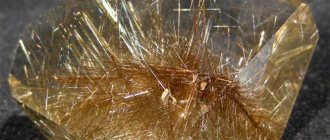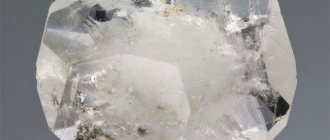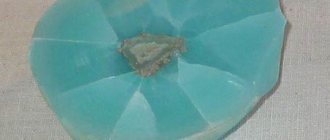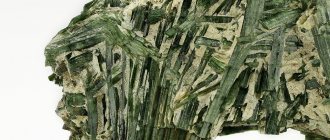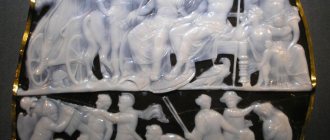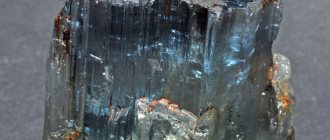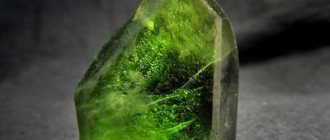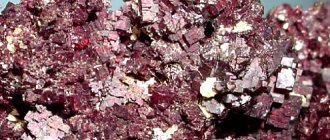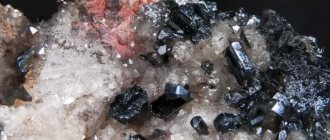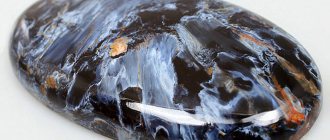Description
The flake stone lepidolite has not been considered a mineral by the International Mineralogical Association since 1989 . In practice, this term refers to light micas, the structure of which is dominated by lithium.
What does lepidolite look like?
The appearance of lepidolite is unusual, reminiscent of dense dragon scales. Stones have a variety of shapes, they can be in the form of:
- cone;
- flat plate;
- sockets with a cluster of layers.
The main color of the mineral is lilac, as well as various shades of violet and lilac. Specimens of yellow, white, and gray colors are rare. It is not often that there are combinations of pink with red, white, blue, and gray shades.
The color and structure of the mineral is heterogeneous. Often the middle of the stone is bright, closer to the edge the color saturation is lost. There is always a shine - either pearly or glassy.
Since the gem has a scaly structure, it does not have purity of color, but it does have a variety of wonderful patterns.
Physicochemical characteristics
Lepidolite is a micaceous representative of flaky silicates. This layered mineral, formed from igneous mica, has a variable composition and complex formula.
- Chemical formula: KLiAl( Al, Si)3 O10( F, OH)2 .
- Impurities - Fe2+, Mn, Cs, Rb, Na .
- Color - lilac, lilac, violet, pink, yellow, gray, white.
- The shine is pearlescent, glassy.
- Transparency - transparent, translucent.
- Hardness - 2,5.
- Density - 2.8 g / cm3 .
The classic color - lilac-lavender - is obtained due to an admixture of manganese.
The structure is layered-scaly, dense, but elastic. If you bend one plate, it will straighten out. This is a unique property of lepidolite. The monolith is strong, although the scales are easily separated from it, but return to their place.
The mineral is characterized by weak pleochroism - its shade changes slightly at different viewing angles. When exposed to ultraviolet light, a pale yellow tint appears.
Interestingly, lepidolite turns into white enamel when set on fire. The flame acquires a carmine-red color.
The stone melts easily and does not dissolve in acids.
Chemical composition
The chemical composition is not constant. K2O from 4.82 to 13.85%, Li2O from 1.23 to 5.90%, Al2O3 from 11.33 to 28.80%, SiO2 from 46.90 to 60.06%, H2O from 0.65 to 3.15%, F from 1.36 to 8.71%. The following are present as impurities: MgO (up to several percent), FeO, MnO, CaO, Na2O, Cs2O, Rb2O3 (sometimes up to 3.73%), etc. A variety that does not contain iron or is poor in it, but is richest in lithium and fluorine, is called polylithionite , in contrast to cryophyllite, in which part of the Li is replaced by Fe2+, and F by OH (transitional difference to zinnwaldite).
Crystallographic characteristics
Syngony. Monoclinic; monoclinic-prismatic type of symmetry.
Symmetry class . Prismatic - 2/m.
Axle ratio. 0.581: 1: 1.124; β =100°48′.
History of the name. Varieties
Lilalith is the name given to the lilac-lavender stone in the 18th century by the German scientist Martin Klaproth. Later they began to call it landrin. The final name appeared in the 19th century , after the scaly structure of the mineral was discovered. The classic term “lepidolite” is translated from Greek as “scaly stone”. Synonyms:
- purple stone;
- litinous mica;
- lithium mica.
The following names are assigned to the varieties of the mineral:
- Lilialite or lavanrine are stones of pinkish-purple color, similar to the color of lavender.
- “Barbot's eye” - samples with a layered-spherical structure. They were found in the 19th century in Russia by Nicolas de Marny.
Currently, the term “lepidolite” is the scientific name for a group of minerals - micas of various compositions and colors.
Care
Lepidolite is a very brittle mineral. Its hardness on the Mohs scale is estimated at only 2.5 points, therefore stone products must be protected from mechanical damage. Such jewelry and household items do not have any special rules for care and storage: they can be washed in warm water with the addition of a small amount of fragrance-free soap.
Products made from lavender mica are valued for their unusual color and specific texture. Lepidolite is a kind of must-have for fashionistas and collectors who want to demonstrate their sophisticated taste to others.
Place of Birth
Lepidolite deposits are found where lava emerges from the bowels of the Earth onto granite. This mineral is found in mountainous areas of different countries:
- Italy;
- Sweden;
- Germany;
- Czech Republic;
- USA;
- Brazil;
- Pakistan;
- Afghanistan;
- Madagascar;
- Russia (Urals, Kola Peninsula, Transbaikalia, Krasnoyarsk Territory).
Lepidolite is found less frequently than other types of mica. Samples suitable for jewelry processing are rare. Collectible specimens are mined in Russia (in the Urals) and in the USA (in the states of California and Maine).
Application
The areas of application of lepidolite are industry, science, decoration, jewelry, and collecting. The bulk of stone mined in Europe goes to industry. Minerals from Brazil are usually suitable for arts and crafts and jewelry.
Industry. The science
Lepidolite is a valuable source for lithium extraction. This metal is needed to create:
- battery parts;
- laser devices;
- pyrotechnics;
- special types of glass;
- pharmaceuticals.
In the nuclear industry, lithium is used for safety during nuclear waste disposal.
It is also used in the synthesis of organic compounds, purification of conditioned air, and production of artificial mineral waters.
Scientists calculate the age of various rocks, since in lepidolite they can easily determine the saturation of isotopes of certain elements.
Decorative arts. Jewelry
When lepidolite is mined, each sample is carefully studied. Unique specimens with unusual coloring and structure are made available to jewelers for making jewelry, and large agglomerates are used to make interior items: vases, boxes, small plastic items.
Stone cutters value stones with tourmaline, which adds strength, and jewelers value quartz, which contains lepidolite inclusions. The fact is that quartz is much harder, it is easy to give it a certain shape. In cabochons you can admire lepidolite protected by a quartz shell.
Lepidolite is a decorative and ornamental stone, its price is low, and it is difficult to make jewelry from it. Therefore, jewelry made from tumbled stone is often sold: inserts of fancy shapes, beads.
Collecting
Lepidolite of unusual structure and color is very rare. The price of such specimens is higher than the cost of lithium, for which the ore is mined. Therefore, the raw materials are carefully examined to find such samples. Collectors value such specimens very much and pay a lot of money for them. Particularly expensive are intergrowths of lepidolite with other minerals or cabochons.
Interesting facts about lepidolite
In jewelry, when polishing and cutting lepidolite samples, two main problems arise: perfect cleavage and low hardness of the stone. During grinding, the mineral easily crumbles, especially when structured from finely scaly aggregates. For this reason, jewelers often do not use independent lepidolite intergrowths, but process quartz with its inclusions. Such specimens of quartz can be easily given a rectangular, spherical or other shape, and the lepidolite is not damaged and can be admired.
Medicinal properties
Lithotherapists believe that the healing properties of lepidolite are provided by the lithium in its composition. This metal has a positive meaning for a person in terms of health.
Official medicine does not confirm the healing properties of lepidolite, but does not provide a refutation either.
The use of lepidolite in treatment is only an addition to the prescriptions of the attending physician.
In lithotherapy, the mineral is valued primarily as a sedative and analgesic. It is used in complex therapy for the following diseases and conditions of the body:
- neuroses;
- depressive states;
- psychoses;
- instability to stress;
- manic-depressive syndrome;
- sleep disorders, insomnia;
- signs of schizophrenia;
- psychosomatic diseases.
In these cases, it is recommended to wear the following jewelry: bracelet, pendant or beads. For a restful sleep, you need to place a stone next to the headboard. It is believed to banish nightmares and aid in dream recall, which is why lepidolite is sometimes called the “dream stone.”
Lepidolite will help the body get rid of tension, as a result of which many ailments can be eliminated, especially brain pathologies, various neuralgia (for these, you can attach the stone to the sore spot with an adhesive plaster).
Wearing earrings will help with migraines and trouble sleeping.
Toothache and headache can be neutralized by applying a pebble to the sore spot.
It is believed that the healing power of this mineral increases near the flame of candles.
Some lithotherapists treat sprains and bruises with lepidolite. After applying the stone to the injured area, swelling is relieved, pain subsides, and tissue regeneration is enhanced.
This mineral is capable of stimulating rapid muscle growth, which is why it is considered a talisman for athletes.
Magic properties
Since lepidolite was discovered recently, its magical properties have not yet been fully studied. There is information about the following magical properties of the stone:
- It has a calming effect on the nervous system, reduces irritability, aggressiveness, and temper. It neutralizes negative energy, gives peace and peace of mind, which is why it is sometimes called the “peace stone.”
- It distracts a person’s attention from routine, prevents depression, and helps in making important decisions.
- Protects from unrequited love, from difficulties in relationships between lovers.
- He is the keeper of the family hearth. Spouses who have such a talisman have no conflicts, as it prevents the outburst of negative emotions.
If you periodically light a candle next to a mineral, its magical power increases.
- Women feel the influence of the mineral especially well. He gives them flexibility, wisdom, and endows them with the qualities of a good housewife.
- The main significance of lepidolite for humans is that it does not allow the owner to get into difficult and dangerous situations. We can say that this is a preventive stone.
- Contemplation of a gem brings consciousness to high levels, banishes thoughts about everyday trifles. For this he is appreciated by adherents of meditation.
- As a talisman, the stone is very suitable for creative and impulsive people. It will help cope with excessive emotions, protect the mental and physical health of such a person, and will help achieve recognition of his creative success.
Esotericists claim that lepidolite is not suitable as a talisman or amulet for people whose professional activities are related to finance. This stone does not accept commercialism; due to its influence, plans may be ruined and the resolution of financial issues will be hampered.
Talismans, amulets and amulets with mineral
Jewelry and decorative items with lepidolite are an integral part of any meditative process. The aura of the mineral promotes accelerated entry into trance, alignment of breathing and heartbeat. Lepidolite will allow beginning mediums to quickly renounce worldly goods and teach them control over their emotional state.
Amulets with this purple stone are ideal for creative individuals. The mineral will allow you to control and cause a flight of inspiration. In this case, imagination will not cross the boundaries of what is permitted; the creator will be able to concentrate on one work without being scattered over the production of several projects.
Lepidolite talismans are especially useful for representatives of the fair sex. Women who own the stone will attract good luck to themselves and their partner. This property of the stone is due to the common vocation of him and the girls - to create and preserve a family hearth, continue the family line and preserve the health of loved ones.
However, not all professions will benefit from lepidolite. For financiers, players and other professions related to money, the stone will be a hindrance.
Who is suitable according to their zodiac sign?
According to the horoscope, lepidolite is ideal for people born under the zodiac sign of Libra. Such a talisman will help smooth out the tendency to causeless mood swings. Life's difficulties will be perceived calmly, and a philosophical view of what is happening will appear. The consequence of these changes will be peace with yourself and the people around you.
Now astrologers are studying the effect of lepidolite on other signs of the zodiac and have already established for sure that this mineral does not harm any sign.
It is likely that personal compatibility with a particular stone plays a greater role than compatibility by zodiac sign. It’s easy to check: hold the gem in your hand for 2–3 minutes . If you don’t feel any discomfort, you can make this stone your talisman.
What astrologers say
According to astrological material, lepidolite correlates with the sign of Libra, which belongs to the air element. However, all representatives of air signs are characterized by lability of mood and some lack of understanding of their own needs. Jewelry and amulets made from this stone contribute to finding inner balance, and as a result, stabilizing relationships with loved ones, colleagues, and just acquaintances.
In principle, to one degree or another, lepidolite is suitable for all signs of the Zodiac. However, there are cases of individual intolerance. This becomes noticeable in the first few minutes of interaction with the stone. If a person does not immediately feel ill, then there is no “allergy”.
How to care
Since products made from this rare stone are unique and handmade, you need to know the rules of care so that they please you longer:
- It is better to store it in boxes that are soft on the inside and appropriate to the size of the product (then the stone will not hit the walls when carried).
- It is better to clean lepidolite with warm water using a soft cloth. If necessary, you can add neutral soap to the water or wipe with pure alcohol.
- The stone should not be overheated, as it does not tolerate high temperatures.
How to distinguish from a fake
It is best to check lepidolite for authenticity in a jewelry workshop that has special equipment. If this is not available, you can pay attention to the following factors when purchasing:
- Glitter must be present (glass or mother-of-pearl).
- The color of most stones is lilac-violet. If it is different (pink, gray, lilac, yellow, white), then it should be the main tone.
- Weak pleochroism - if you look at a pebble from different angles, its hue changes slightly.
- flaws on the surface , as jewelers polish the stone until it is uniform.
Price
Despite the rarity of the stone and the complexity of its processing, jewelry made from pure lepidolite (that is, without combination with quartz) can still be purchased. Since costume jewelry is mainly made from this mineral, the cost of jewelry made from it is low (price/rub.):
- pendant without frame - from 2000 ;
- alloy earrings - 500–2500 (sometimes up to 9000) ;
- ring - 700–5000 (depending on the jewelry alloy);
- beads made from small beads from Brazilian mineral - from 3500 ;
- egg 60 x 40 mm - from 3500 ;
- cabochon size 42 x 19 x 1 mm - from 350 .
Quotes
Collectors are chasing well-cut specimens of non-standard colors, especially when intergrown with other minerals. For each such sample, unimaginable sums of money are paid.
Below are prices for lepidolite in Russian stores:
- Galvanized pebble with a diameter of about 35 mm - the cost can vary significantly from 300 to 1200 rubles;
- Lithium ore concentrate with dimensions 105x56x50 mm - 1.5 thousand;
- Ore with tourmaline inclusions with dimensions 70x52x47 mm – 900 rubles;
- Zonal ore concentrate with dimensions 59x42x2 mm - 350;
- Lepidolite egg with tourmaline inclusions 53x40 mm – 3660 rubles;
- Ball (with inclusions of tourmaline, feldspar) with a diameter of 75 mm - 7200.
